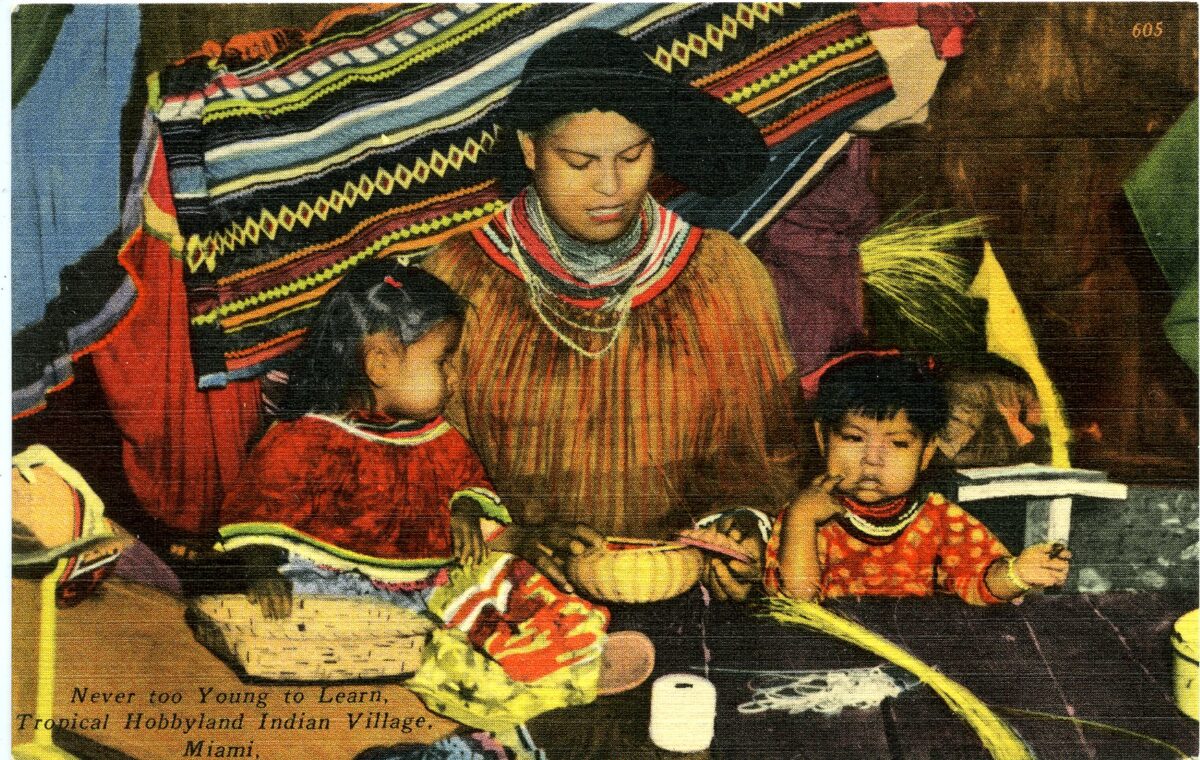
The History of Seminole Sweetgrass Baskets
Have you ever seen a Seminole sweetgrass basket? Colorful, vibrant, and sturdy these baskets are gorgeous examples of Seminole artistry. Seminole crafts are an important, but threatened, part of Seminole culture. Made from plants indigenous to Florida, they were first sold in the early 20th century to tourists. Follow along this week to learn all about sweetgrass baskets, how they are made, and what they are made of. Also, stay tuned for other examples of Seminole basket-making, and the importance of these Seminole crafting traditions!
Modern Sweetgrass Baskets
With the rise of the tourist boom, sweetgrass baskets became a popular item to sell to tourists. While basket-making had a long tradition in Seminole culture, sweetgrass baskets have only been at the forefront for about 60 years. In a previous post about the first Seminole tourist camps, we discussed the difficulty and hardships that Seminoles faced since European contact. Prior to the tourist boom, time and effort were put into functional baskets. Surviving in the Everglades was hard, and making decorative baskets was not a priority. But, once Seminole crafts began to sell at tourist camps, especially along Tamiami Trail, it became increasingly important to make the crafts eye-catching. Sweetgrass baskets began to be more complex, and show more of the individual artist’s style. Now, they represent generations of talent, artistry, and dedication.
The skills to weave baskets are passed down from older women to younger girls. The linen postcard featured above shows Ruby Bert (center) making a coiled sweetgrass basket. To her immediate left is a young Nancy Willie Jim, and to her right is Jenny Osceola Billie. Girls would have learned how to make sweetgrass baskets like this; watching older women and being taught from a young age. Without skilled makers passing knowledge down, making crafts like sweetgrass baskets would be lost. In a previous blog post about the Power of Postcards, we talked a bit about these linen type postcards. The original black and white photo would have been taken at Tropical Hobbyland in Miami. The image then would have been retouched and colored by an artist for mass production. Along with Seminole crafts like sweetgrass baskets, postcards would have been sold in the tourist camps for income.
Making Sweetgrass Baskets
Making sweetgrass baskets takes a considerable amount of skill, effort, and knowledge. Wild sweetgrass is harvested blade by blade, and it is getting increasingly difficult to find. The hand-picked sweetgrass blades are found in high, dry areas of the Everglades. The blades are pulled up a few strands at a time until a small bundle can be made. The strands are washed, bundled, and dried in the sun. Basket bases are made of palmetto fiber, and the sweetgrass bundles are coiled and built up around the base and sewn with colored thread. The coils can run clockwise or counter-clockwise depending on the dominant hand of the maker. While this is the basis for all sweetgrass baskets, each artisan has their own style and flair in basket making that is unique to them.
Sweetgrass baskets can take many shapes, sizes, and forms. Previously, when we discussed how to be an ethical consumer of Native arts and crafts, we featured a small sweetgrass basket that was received at the Seminole Tribal Fair and Powwow in 2018. While that basket is small and flat with two handles, baskets can be as large or as complicated as the artist desires. Each artist can have a different style and pattern of stitch work that is as unique as a set of fingerprints. The colorful threading is used to sew the coiled sweetgrass together, but is also a way to express specific artistic styles. Some artists sew patterns, shapes, and designs with the threading. This creates a bold, visually impactful basket, and is one way that these baskets are exclusive to each maker.

Doll Head Basket, 2002.166.63, ATTK Museum
Doll-head Sweetgrass Baskets
One unique type of sweetgrass basket melds two kinds of traditional Seminole crafts. Seminole doll making is another iconic traditional craft. With palmetto fiber faces and tiny, traditional patchwork clothes, hairstyles, and jewelry, dolls are meant to portray a Seminole man or woman in miniature. With embroidered facial features and bold colors, they are a favorite item bought at Tribal events past and present. But, did you know that some sweetgrass baskets feature Seminole doll-heads on the lids?
Possibly one of the more unique types of sweetgrass baskets are doll-head baskets. Often, the doll-head is incorporated on the lid of the basket, like the one shown here from the Ah-Tah-Thi-Ki Museum collection. This bell-shaped basket is striking and large. The doll-head has traditional style beaded necklaces and earrings, beaded hairstyle, embroidered facial features, and a beaded button closure on the basket lid. Truly, this doll-head basket is a piece of art that required a lot of skill to design and create. Just by looking at it, you can tell it is a Seminole basket!
Saw Palmetto Baskets
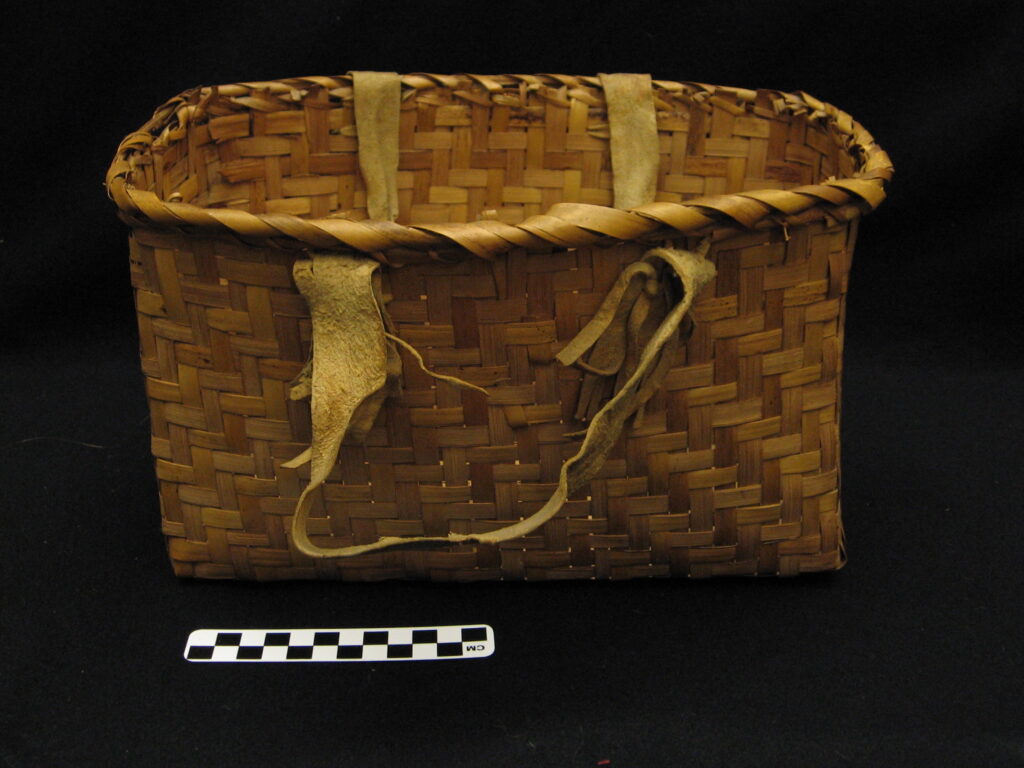
Saw Palmetto Basket, 1996.39.10, ATTK Museum
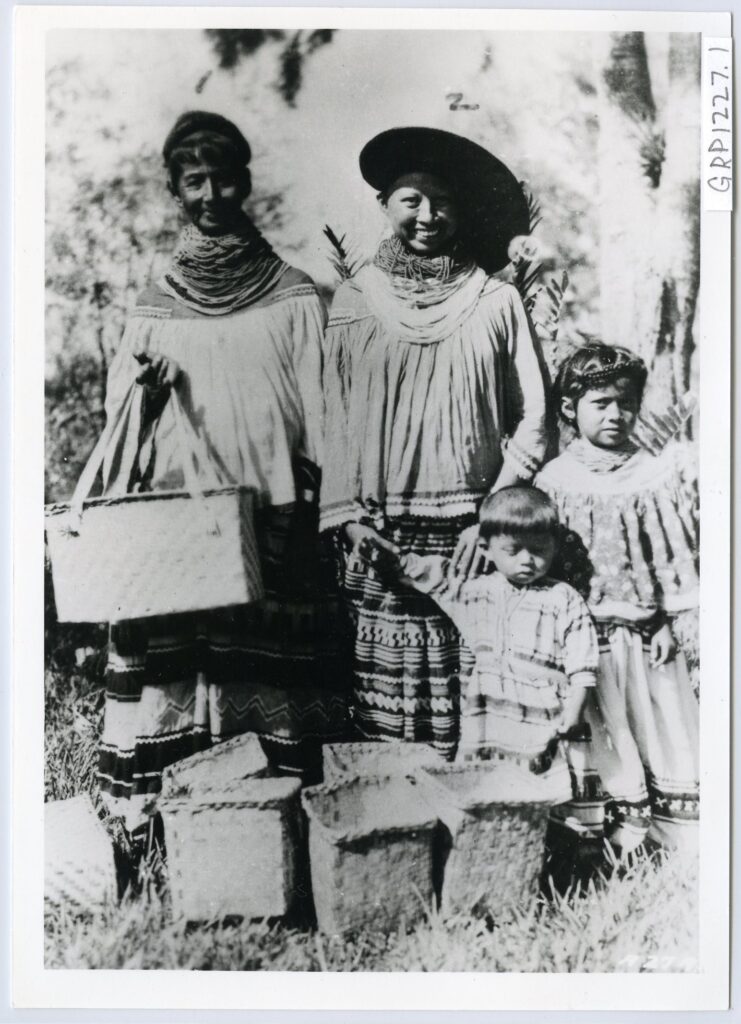
Market Baskets, GRP1227.1, ATTK Museum
Many sweetgrass baskets today are sold as luxury decorative items. They are intricate and represent hours and hours of work. From gathering sweetgrass, designing, coiling, and forming the basket they take a long time! But, prior to the tourist boom many baskets were utilitarian and focused on function. Although decorative sweetgrass baskets have been the dominant type of basket for the last 60 years, basket making has been an important part of Seminole tradition for generations. An example of this would be saw palmetto baskets. Saw palmetto is a common palm-like shrub. It is found throughout Florida, and has fan shaped leaves. Important to the biodiversity of the Everglades, saw palmetto supports a wide range of animal life. A variety of birds, mammals, amphibians, reptiles, and insects depend on saw palmetto for either shelter or food. Below, you can see an example of a saw palmetto market basket from the Ah-Tah-Thi-Ki Museum Collection.
Unlike the more decorative sweetgrass baskets, this basket would have been used regularly to carry food or goods. It is very functional, with a deep rectangular opening and buckskin handles. While it also would have taken a long time to make, and required skilled knowledge, it is less decorative and more utilitarian in style. Similar style palmetto market baskets can be seen here in this early 20th century photo. A number of different shaped baskets can be seen at the women’s feet. The smaller baskets with square openings are possibly berry baskets, due to their size and shape. Pack baskets, envelope baskets, and sieve baskets are other types of functional baskets that would have been used for generations.
Revitalizing Seminole Crafting Traditions
Learning how to make saw palmetto and sweetgrass baskets takes a lot of time and dedication. Additionally, in the last few generations it has become increasingly important to work to keep these traditions alive. The skills are passed down from person to person by watching and observing them. Since saw palmetto baskets are not as popular anymore, fewer and fewer people learn as children to make these types of baskets. Sweetgrass baskets are made, but also require a lot of learning and skill. But, more and more Seminole tribal members are recognizing the need to revitalize the interest in these crafts.
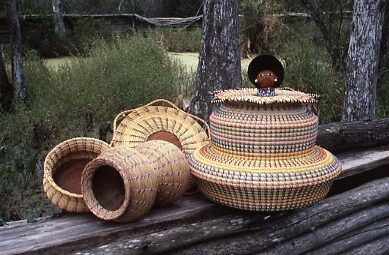
Sweetgrass baskets, GRP1900.74, ATTK Museum
Environmental concerns are also impacting traditional crafts. Sweetgrass, which used to be abundant on the landscape, is taking a hit as Florida becomes more and more developed. Scrub lands, where sweetgrass grows best, are being built over. Identifying and gathering sweetgrass also takes a skilled eye and hand. Cultural programs and skilled cultural advisors work to teach people of all ages skills that they can pass on. Without dedication to passing these crafts along, the skills could be lost. It is incredibly important to the Seminole Tribe of Florida that these skills are passed along into the community, for generations to come! Next Friday, make sure to tune in to explore more about sweetgrass basket makers and how they are working to protect this traditional knowledge.
If you would like to see some Seminole baskets, as well as support Seminole creators, visiting the Ah-Tah-Thi-Ki Museum and the Ah-Tah-Thi-Ki Museum Marketplace is a great first step! We encourage you to join in on Museum and public Seminole Tribe of Florida events, peruse the Museum Online Collection, and support indigenous artists.


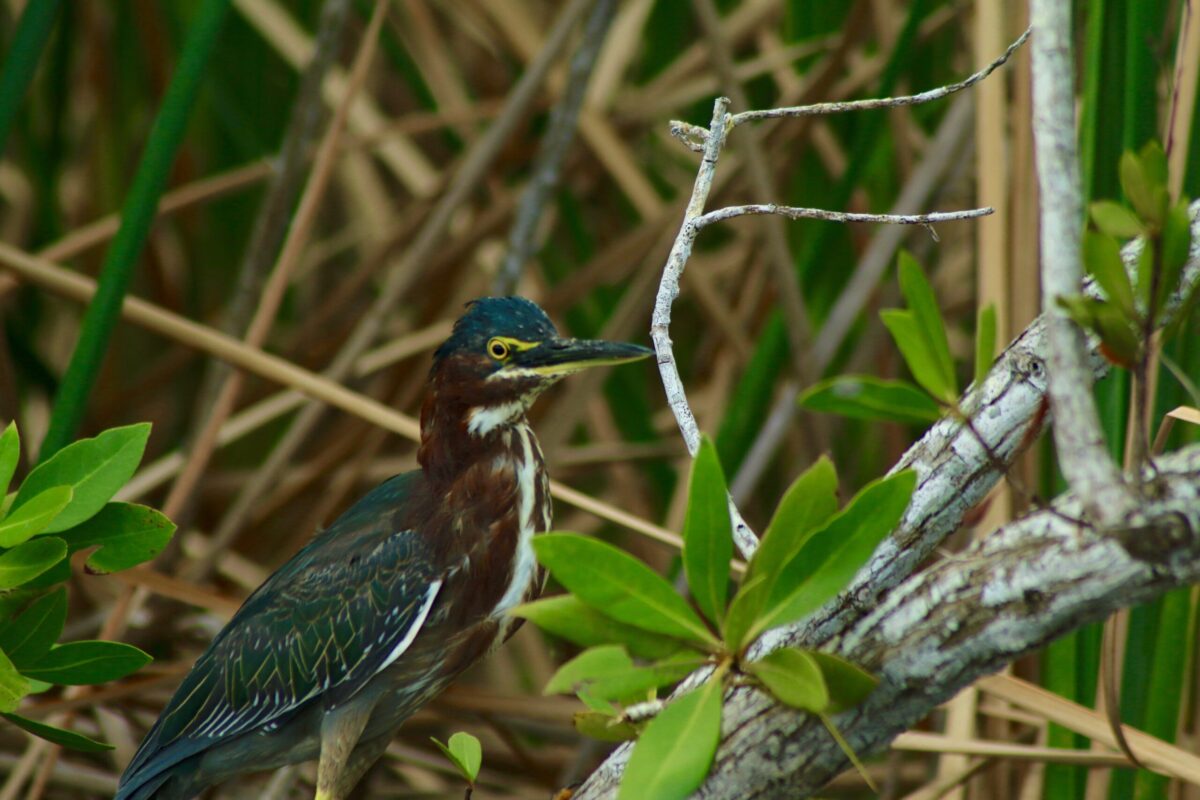
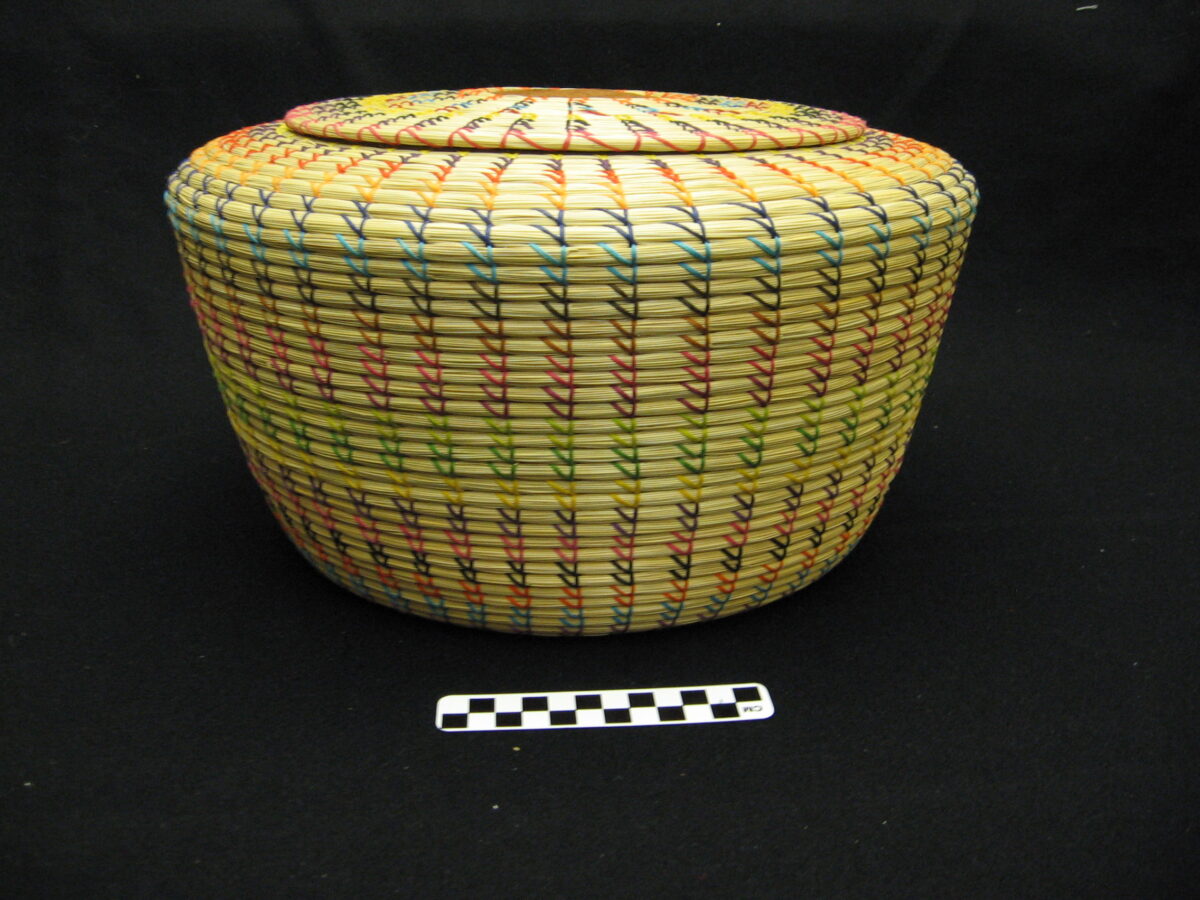
Bob Beland
Are there any basket weaving classes?
Carrie Dilley
Thank you for asking! At this time, there are no classes open to the public.